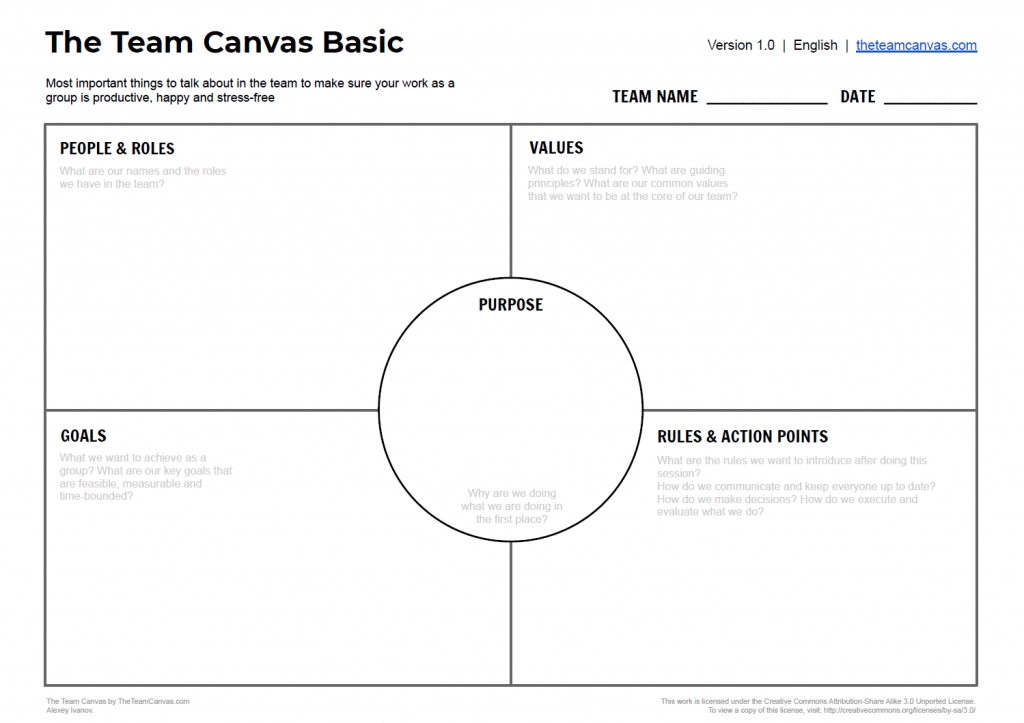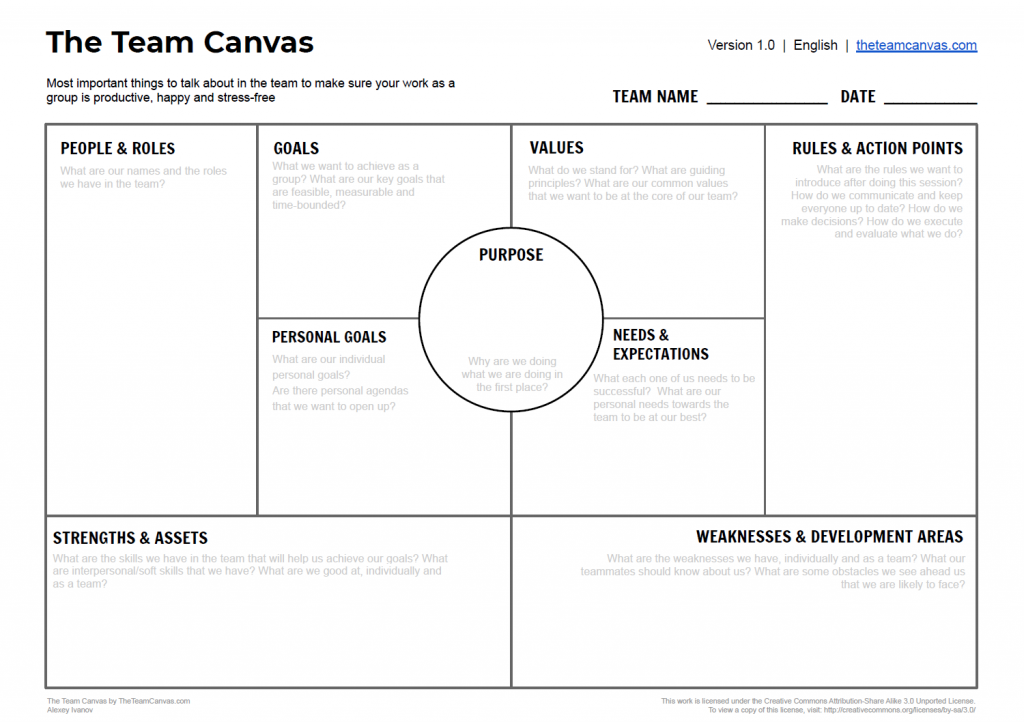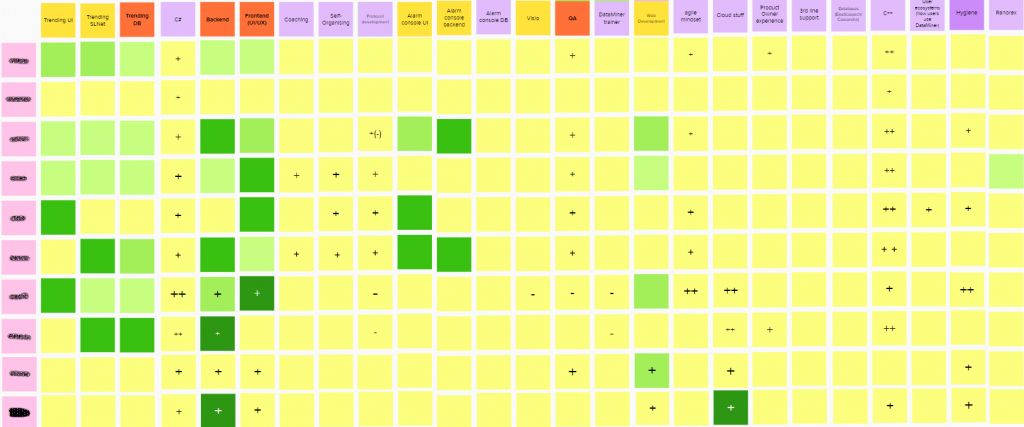Agile Webspace > Best Practices
In Agile, the team is at the heart of everything. Whether you use SCRUM, Kanban, or another method, having a strong, growth-oriented team is key to success. Here are some best practices for building and strengthening your Agile team.
Make a Team Canvas
Creating a team canvas is a great way to answer initial questions and keep the team aligned and focused. Use this basic template to get started, and then adapt and expand it as needed.


Create an agile Battle Plan (team charter)
A central document that makes the team's implicit agreements explicit. Include details about team members, policies, tooling, events, and more. This document should be inspected and adapted regularly to ensure the entire team is aligned and adapts to change. It can also serve as a reference for other teams looking to improve or for new team members joining.
Build a Team Skill Matrix
A cross-functional team is essential for success. Use a skill matrix to map each team member's skills, and identify gaps. If the team lacks certain skills, seek help from local experts or offer training. Make sure to promote collaboration and negotiate with the Product Owner to ensure everyone has time to learn new skills.

Build up the SCRUM values
The values of Courage, Focus, Commitment, Respect, and Openness are important for high-performing teams. Build trust, work through conflict, commit to decisions, hold each other accountable, and focus on achieving company-wide goals.
Eliminating Waste
Maximizing value means eliminating waste. Here are some tips for making the most of your team's time.
- Plan meetings with a clear goal and time-boxed topics.
- Adhere to timeboxes to ensure people are focused.
- Reserve time at the end of meetings to determine the next action.
- Use retrospectives to note down waste and determine how to avoid it in the future.
The Right Data
Good metrics are essential for identifying problems and verifying the outcome of your actions. Make sure you get the right data by being transparent and focusing on trends, rather than snapshots.
Apply systems thinking to your metrics. Tracking and improving one metric can often lead to incorrect conclusions. Try to combine a couple of factors into a single graph: speed, quality, team satisfaction & timing.
Quick tips for the Agile Coach and their team
Removing impediments
Use the SMITH method as an Agile Coach to identify and address obstacles to progress.
- Setup: ensure a shared workspace and clear roles.
- Mentoring: provide feedback and opinions only when asked.
- Input instead of direction: allow the team to self-manage and make decisions.
- Training: ensure the team has the skills they need to be successful.
- Hiring: involve the team in defining what they need in a new team member, but don't let it slow down the process.
Flow problems
Use the PEACH method to identify and address flow issues.
- Pessimistic: encourage the team to take risks and avoid underestimating their capacity.
- Epics: help the team break down large epics into smaller user stories and tasks.
- Adding too much work: focus on the delivering the most valuable thing rather than maximizing the output.
- Cooking the books: the team focuses on getting good metrics, not value
- Hang gliding: avoid letting tasks get stuck in "ongoing" or testing. Make sure testers and developers are collaborating closely to avoid having waterfall in your sprint.
Dependencies
- Engage early
- Get a clear scope & deadlines
- Hold SCRUM of SCRUMs (SoS) to ensure alignment across teams.
Team collaboration
Address interpersonal conflicts head-on, establish team norms, and use creative approaches to keep retrospectives and other meetings productive.
Dysfunctional sprint planning
Preparation is key for the sprint planning. Check the top priority user stories. These should be refined. That means they should be small enough to fit a sprint and have clear acceptance criteria that mitigates the risk of building the wrong thing.
Involve the development team in this, use plain language everyone understands, and include both functional (the what) and nonfunctional (the how) criteria. Make sure everyone in the team agrees with the result.
If the preparation is not okay, it's the job of the agile coach to let the team fail and point out how to move further during the planning. For example:
- If the PO says "I don't know" when asked about something during planning, that means the story can't be planned and we move on to the next one.
- If too many stories are unrefined, convert the planning into a refinement meeting. At this point, there is no sprint until we have enough items that can be planned.
- If the PO is too involved in how to build things rather than the how, make sure the PO understands that the team has the skills needed to do the job and that they should be trusted to do exactly that.
When the Agile Coach is away
Find a suitable replacement. Preferably one from another team. Assign a team member the role if you have to, but it's probably best to avoid this if you can.
When the Product Owner is away
- Make sure that the backlog is well-refined.
- Find a short-term replacement from another team.
- Encourage stakeholder engagement to ensure continuous communication.
Customer collaboration
Customer collaboration is an important aspect of Agile development. Engaged stakeholders can provide valuable feedback and perspectives, but it's important to make sure that the right people are involved and that communication is clear. If the sprint review is not functioning well, it may be necessary to take action. Some steps you can take include:
- Inviting the appropriate stakeholders, particularly those who use your product.
- Speaking the language of the stakeholder, using user stories instead of technical jargon.
- Helping stakeholders understand their role and importance in the process, building trust and confidence.
- Establishing continuous, transparent communication that is asynchronous and responsive to stakeholder needs.
While the development team typically owns the standup, it can be beneficial to involve stakeholders if they can provide valuable input to the product.
Continuous delivery
Avoid burned-out teams by introducing walking sprints. Reduce the sprint commitment by half and let the team get a breather. Evaluate how to avoid overcommitment in the future, and ensure that the team has the necessary resources to deliver quality work.
In-depth
Being agile can manifest ("manifest", get it?) itself in many different ways. Check out our posts on a plethora of topics:
- A real Sprint Review Meeting
- 2 warm-up exercises that turn disconnected meetings with low participation into effective & engaging work meetings
- Do you have to answer “the three questions” during every Daily Scrum?
- What do we do with unfinished work at the end of the Sprint?
- Retrospective recipes to go
- Best practices to order your product backlog
- Peer feedback
- Monte Carlo Simulations – Predictability in complex environments
Lean Coffee @ Izegem
Would you rather BE a change agent than reading about them? Join the Lean Coffee meetups organized by our Global Agile Lead Bram De Block at our state of the art HQ and become the change you want to see!
The Lean Coffee meetups link is dead (“group not found”)
Hey Brecht, thanks for letting us know! I updated the link to point towards LinkedIn, which is where we are organizing them now. We are still looking into the details there though, so not much to see yet.
Looking forward to welcoming you to Skyline!